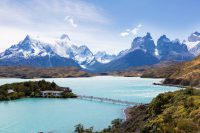As the Southern Hemisphere spring and summer approach, our thoughts turn to a Patagonia vacation, but many of us have only a vague idea what that means. Consequently, I’d like to take an opportunity to define the region that has stimulated the imagination since Ferdinand Magellan first landed there in the 16th century.
Intending visitors may think first of iconic landscapes like Torres del Paine and the Perito Moreno Glacier but, most broadly, Patagonia comprises much of southernmost South America (mostly Argentina, but also parts of Chile). Its name probably derives from the first aboriginal inhabitants that early explorers encountered – “Patagones,” roughly translated as “people with big feet.” Though its etymology is unclear, this descriptive term for people who dwarfed the Spaniards in stature may have originated with Magellan’s Italian chronicler Antonio Pigafetta.
Hearsay grew that legend, but the region’s native people are still a good starting point for defining the region. Until the late 19th century, the Tehuelche, Mapuche, Huilliche, Puelche and other mobile peoples dominated the area south of the Río Colorado (in Argentina) and the Río Biobío (on the Chilean side), and they are still a presence today – most conspicuously in Chile.
Broadly speaking, those boundaries still exist today: by broad consensus, Argentine Patagonia consists of the mainland provinces south of the Colorado – Río Negro, Neuquén, Chubut and Santa Cruz – plus its sector of the Tierra del Fuego archipelago. Much of this is a “Big Sky Country” – think Montana, but with an Atlantic coastline populated by marine mammals (whales and seals) and penguins.
In Chile, Patagonia traditionally begins at the channels and fjords of the thinly populated and densely forested Aisén region – almost roadless until recently – where ferries and airplanes have long been the main means of transportation. It’s an area that resembles British Columbia and the Alaska Panhandle.
Chile’s southernmost region of Magallanes, which includes part of the Tierra del Fuego archipelago, is indisputably Patagonia, but the more northerly “Lakes District” south of the Biobío has actively embraced the designation – in that sense, “Patagonia” is becoming an informal brand. In an area resembling Oregon and Washington, this brings the Chilean boundaries more closely in line with those in Argentina, and cross-border travel is routine here.
Geographically, Argentine Patagonia about the same size as Texas or Turkey, and Chilean Patagonia roughly comparable to Germany, but environmentally speaking the differences are striking. As you travel west, Argentine Patagonia’s thinly vegetated steppe turns to southern beech forest as it approaches the relict glacial lakes on both sides of the Andes. Farther south, the steppe becomes Magellanic moorland, while the glaciers and icefields still survive – a great reason to get to know this vast area, but far from the only one.
No comments yet
There are no comments on this post yet.





Leave a comment